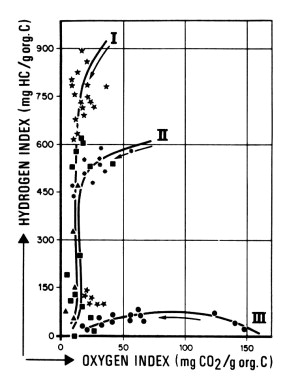Site Navigation
Oilfield expertise at your desktop
Kerogen
Kerogen is defined as organic constituent of sedimentary rocks which is not soluble in normally found organic solvent due to its higher molecular weight. Soluble portion of kerogen is called as bitumen. Kerogens are made up of variety of organic materials like wood, pollen, algae etc. When heated as per required correct temperatures in earth crust they release crude oil or natural gas, depending upon temperature at which it is heated.
Temperature of oil window to release oil is 50-150degC and to release gas is 150-200degC.The type of kerogen present in the rock controls the type of hydrocarbon generated and they are the major factor controlling oil vs. gas yields in reservoirs. High amount of kerogen present in shales makes them source rock. If shales have high kerogen content but have not exposed to higher temperatures may form shale oil reservoirs.

Figure 1. “Van Krevelen diagram”
Kerogens are classified as Type-I, Type-II, Type-III & Type-IV kerogen. “Van Krevelen diagram” can be used to classify Kerogen. “Van Krevelen diagram”cross-plots the hydrogen index with oxygen-index as function carbon atomic ratios. The most common use of Van Krevelen diagram is differentiating various types of kerogen.
Type-I Kerogen, Sapropelic:-oil shales with this type of kerogen that provides the maximum output of oil and are considered as best conventional oil deposits.
Type-II Kerogen, Planktonic/ planktonic and Sulfurous:- It is mainly composed of organic materials of marine origin, formed in the absence of oxygen. High quantity of Sulfur is also found in considerable amounts. Pyrolysis of Type II kerogen produces lower quantity of oil than that of Type I, however amount of oil produced is still good enough to regard Type II rocks as possible oil sources.
Type-III Kerogen, Humic:- Type III kerogen is formed by continental plant matter which does not have much of waxy matter and lipids. Type III kerogen is least productive for oil generation upon pyrolysis and hence they are least favourable when it comes to generating oil.
Type IV Kerogen, Residue:- Type IV kerogen mainly contains organic matter which is already decomposed.They don’t have any possibility to produce any type of hydrocarbon.
| Kerogen Type | Hydrocarbon Potential | Quantity of Hydrogen | Likely Depositional Environment |
| I | Oil | Abundant | Lacustrine |
| II | Oil and gas | Moderate | Marine |
| III | Gas | Small | Terrestrial |
| IV | primarily vitrinite | None | Terrestrial(?) |
